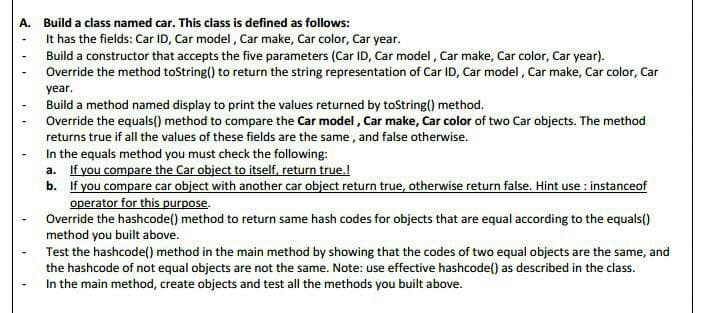A. Build a class named car. This class is defined as follows: It has the fields: Car ID, Car model, Car make, Car color, Car year. Build a constructor that accepts the five parameters (Car ID, Car model, Car make, Car color, Car year). Override the method toString() to return the string representation of Car ID, Car model, Car make, Car color, Car year. Build a method named display to print the values returned by toString() method. Override the equals() method to compare the Car model, Car make, Car color of two Car objects. The method returns true if all the values of these fields are the same, and false otherwise. In the equals method you must check the following: a. If you compare the Car object to itself, return true.! b. If you compare car object with another car object return true, otherwise return false. Hint use : instanceof operator for this purpose. Override the hashcode() method to return same hash codes for objects that are equal according to the equals() method you built above. Test the hashcode() method in the main method by showing that the codes of two equal objects are the same, and the hashcode of not equal objects are not the same. Note: use effective hashcode() as described in the class. In the main method, create objects and test all the methods you built above.
A. Build a class named car. This class is defined as follows: It has the fields: Car ID, Car model, Car make, Car color, Car year. Build a constructor that accepts the five parameters (Car ID, Car model, Car make, Car color, Car year). Override the method toString() to return the string representation of Car ID, Car model, Car make, Car color, Car year. Build a method named display to print the values returned by toString() method. Override the equals() method to compare the Car model, Car make, Car color of two Car objects. The method returns true if all the values of these fields are the same, and false otherwise. In the equals method you must check the following: a. If you compare the Car object to itself, return true.! b. If you compare car object with another car object return true, otherwise return false. Hint use : instanceof operator for this purpose. Override the hashcode() method to return same hash codes for objects that are equal according to the equals() method you built above. Test the hashcode() method in the main method by showing that the codes of two equal objects are the same, and the hashcode of not equal objects are not the same. Note: use effective hashcode() as described in the class. In the main method, create objects and test all the methods you built above.
Computer Networking: A Top-Down Approach (7th Edition)
7th Edition
ISBN:9780133594140
Author:James Kurose, Keith Ross
Publisher:James Kurose, Keith Ross
Chapter1: Computer Networks And The Internet
Section: Chapter Questions
Problem R1RQ: What is the difference between a host and an end system? List several different types of end...
Related questions
Question

Transcribed Image Text:A. Build a class named car. This class is defined as follows:
It has the fields: Car ID, Car model, Car make, Car color, Car year.
Build a constructor that accepts the five parameters (Car ID, Car model, Car make, Car color, Car year).
Override the method toString() to return the string representation of Car ID, Car model, Car make, Car color, Car
year.
Build a method named display to print the values returned by toString() method.
Override the equals() method to compare the Car model, Car make, Car color of two Car objects. The method
returns true if all the values of these fields are the same, and false otherwise.
In the equals method you must check the following:
a. If you compare the Car object to itself, return true.!
b.
If you compare car object with another car object return true, otherwise return false. Hint use : instanceof
operator for this purpose.
Override the hashcode() method to return same hash codes for objects that are equal according to the equals()
method you built above.
Test the hashcode() method in the main method by showing that the codes of two equal objects are the same, and
the hashcode of not equal objects are not the same. Note: use effective hashcode() as described in the class.
In the main method, create objects and test all the methods you built above.
Expert Solution
This question has been solved!
Explore an expertly crafted, step-by-step solution for a thorough understanding of key concepts.
Step by step
Solved in 3 steps with 4 images

Recommended textbooks for you

Computer Networking: A Top-Down Approach (7th Edi…
Computer Engineering
ISBN:
9780133594140
Author:
James Kurose, Keith Ross
Publisher:
PEARSON

Computer Organization and Design MIPS Edition, Fi…
Computer Engineering
ISBN:
9780124077263
Author:
David A. Patterson, John L. Hennessy
Publisher:
Elsevier Science

Network+ Guide to Networks (MindTap Course List)
Computer Engineering
ISBN:
9781337569330
Author:
Jill West, Tamara Dean, Jean Andrews
Publisher:
Cengage Learning

Computer Networking: A Top-Down Approach (7th Edi…
Computer Engineering
ISBN:
9780133594140
Author:
James Kurose, Keith Ross
Publisher:
PEARSON

Computer Organization and Design MIPS Edition, Fi…
Computer Engineering
ISBN:
9780124077263
Author:
David A. Patterson, John L. Hennessy
Publisher:
Elsevier Science

Network+ Guide to Networks (MindTap Course List)
Computer Engineering
ISBN:
9781337569330
Author:
Jill West, Tamara Dean, Jean Andrews
Publisher:
Cengage Learning

Concepts of Database Management
Computer Engineering
ISBN:
9781337093422
Author:
Joy L. Starks, Philip J. Pratt, Mary Z. Last
Publisher:
Cengage Learning

Prelude to Programming
Computer Engineering
ISBN:
9780133750423
Author:
VENIT, Stewart
Publisher:
Pearson Education

Sc Business Data Communications and Networking, T…
Computer Engineering
ISBN:
9781119368830
Author:
FITZGERALD
Publisher:
WILEY